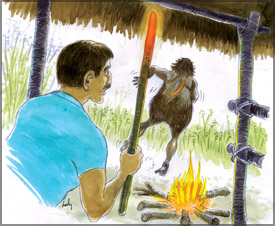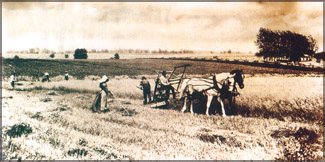|

Folk tales of Sri Lanka:
Demon learns a bitter lesson
Retold by R. S. Karunaratne
Andiris and Hendiris were two brothers who used to do chena
cultivation in their village. They would cut down trees and set fire to
leaves.Then they would wait for the rainy season to plant vegetables.
Andiris, the elder brother, was a lazy man to do cultivation. He
would sit under a tree and fall asleep while his
 brother
tilled the land and prepared it for cultivation. Meanwhile, a demon who
lived in the forest was very angry because he lost part of his kingdom
for a cultivation. brother
tilled the land and prepared it for cultivation. Meanwhile, a demon who
lived in the forest was very angry because he lost part of his kingdom
for a cultivation.
Andiris and Hendiris had another problem with wild animals who
devastated the plantation at night. As a result, the two brothers had to
spend the night in a watch hut on top of a tree. They did this on a
pre-arranged schedule. If Andiris did the night shift on Monday Hendiris
would do it on Tuesday.
The demon who was watching them at night thought that he too should
creep into the watch hut. So, one day, while Andiris was working as the
watcher, the demon appeared before him. Andiris was so scared of the
demon that he started shivering.
“I mean no harm to you. You have only to give me something to eat and
scratch my back until I fall asleep,” the demon said.
Andiris agreed to do so and the demon came to the hut on days when he
was there. However, the demon did not dare to come to the hut when
Hendiris was there.
Very soon Hendiris came to know that his brother was having some
problems with a demon. He decided to teach the demon a bitter lesson.
One day Hendiris dressed himself like his brother and went to the hut
carrying a crowbar with him. Instead of sleeping in the hut on the tree,
he moved into the other hut put up under the tree. There he lit the
hearth and put one end of the crowbar into it.
The demon came to the hut and ate a big plate of manioc and lay down
on a mat. Then he asked the man sleeping beside him to scratch his back.
Hendiris cautiously pulled out the heated crowbar from the hearth and
placed it on the demon’s back.
The demon got such a shock that he started running away promising
never to return. From that day demons are scared of objects made out of
iron.
The rat
It was a rat
It was a rat
It ruined the lattice

It ruined the door
In the night
The middle of the night
There came a muffled scrunch
Then came a crunch
Then there came crunchy scrunch
And a bang
Then suddenly came a huge BANG!
We opened the kitchen door
My! What the rat had done
There at our feet lay the lattice
Once the friend of the window
Alas! The door
The store room door
Was lying on its face
Because of a rat
What a shame
Because of a RAT!
Nillasi Liyanage
Gr. 8 D
Musaeus College
Colombo 7
Thoughts that helped make the world a better place:
The industrial revolution
Industrialism begins in Britain
Throughout the 1700s, a revolution was taking place in England. The
Industrial Revolution changed the way goods were made. Instead of being
made by hand, goods were produced by machines powered by water and
steam.
The Industrial Revolution started in Britain for several reasons. The
country’s population doubled in the
1700s, providing labour for factories and markets for products.
Britain also had a rich supply of raw
|

Steam Engine
James Watt, 1769
Powers machinery
more efficiently than
water power. |

Power Loom
Edmund Cartwright, 1785
Weaves cheaper textiles more quickly. |

LocomotiveRichard Trevithick, 1804 Uses steam power to
transport goods and
passengers. |

Blast Furnace
Henry Bessemer, 1855
Produces better,
stronger, less
expensive steel. |
materials, especially coal and iron. Britain also had many
merchants who knew how to run businesses.
New inventions and industries
By the middle 1700s, the growing population created a demand for
textiles, or cloth. New machines were invented to spin and weave cloth.
The first machines were powered by running water. They were housed in
large buildings called factories, located near swift streams.
The steam engine, invented by James Watt in 1769, used coal for fuel
and provided a steady source of power. With the invention of the steam
engine, factories could be built almost anywhere although most were
built near coal mines.
The new factories used large quantities of coal. Fortunately, coal
was plentiful in Britain. The new industries also needed iron to make
machines. Britain also had plenty of iron ore. Within a few years,
Britain’s iron output went up 400 percent.
New products
The Industrial Revolution started with textiles, but quickly spread
to the manufacture of entirely new products. None created as much
interest or was as important as the steam locomotive and the iron rails
on
|

McCormick’s reaper enabled farmers to harvest larger crop
yields. Before the reaper, farmers had cut their corps by hand
with a scythe, a tool like the one below. |
which it ran.
The iron horse
The first passenger railroad in Britain opened in 1825. In 1829, a
locomotive named the Rocket ran at the astounding speed of 16 miles per
hour.
Within 15 years, more than 1,000 miles of track crisscrossed Europe.
By 1870, the railroad had cut the travel time from London, England, to
Edinburgh, scotland, a distance of 370 miles, from 4 days to 12 hours.
In 1888 the railroad, now nicknamed the “iron horse,” linked Europe
from Calais, France, in the west all the way to Constantinople, Turkey.
Passengers and goods could now reach distant places faster than ever
before.
Steam-powered ships
The steam engine was also used to power ships. In 1807, Robet Fulton,
an American, built the first successful steamboat. People hooted at the
vessel, calling it “Fulton’s Folly.”
However, it proved useful by running from New York City to Albany,
New York, a distance of about 150 miles, on its first voyage. Before
long, steamships were carrying passengers and cargo on the rivers of the
world. The first steamship crossed the Atlantic Ocean in 1838.
New machines for farmers
During these same years, there were many changes in agriculture.
Farmers learned to rotate, or change, crops to produce more of each crop
from the same field. They also used new fertilizers to increase their
crop yields.
The new factories paid higher wages to workers than a farmer could.
Many young people moved to the cities to look for work in the new
industries. Farmers needed help if they were to care for their larger
harvests.
New machines were developed to take the place of farm workers. Cyrus
McCormick, an American, improved the horse drawn reaper, a machine that
uses sharp blades to cut and harvest grain. A farmer could cut, or reap,
2 or 3 acres of wheat in one day. With the new reaper, the same farmer
could increase the harvest to 12 acres a day.
Another American, John Deere, developed a better plough. The old
wooden ploughs were unable to break up roots of grasses in new fields in
the Great Plains of the United States.
Deere took a steel saw and bent it across a log. His new steel plough
cut through the roots easily.
All of these changes made farm products cheaper and more plentiful.
Farms increased in size to take advantage of the new machines. Farmers
began to run their farms as businesses, making farming more profitable.
(To be continued) |

